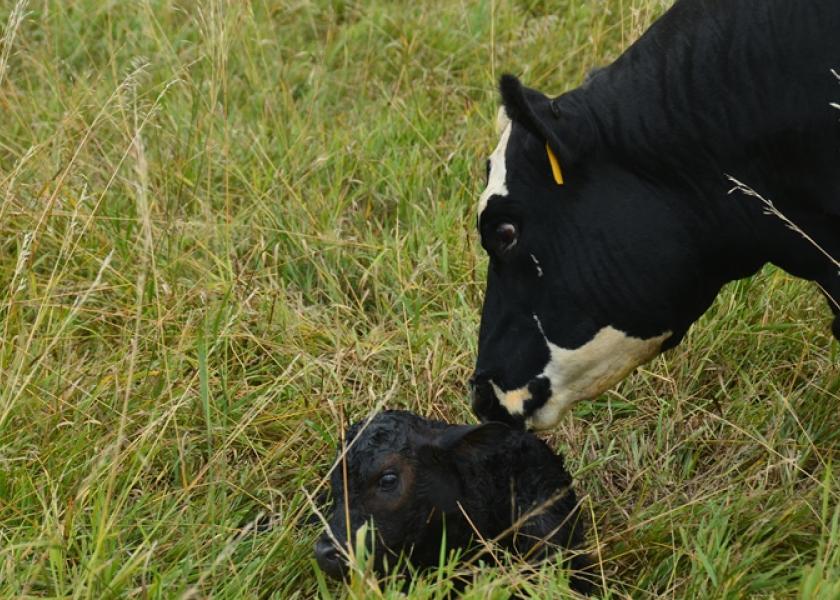Boosting Calf Health Following Calving

While calving season is oftentimes the most exciting time of the year for producers, it can have a dark side when sickness and death occur. Ensuring cows are in an adequate nutritional status (body condition score of 5 or 6) and not overfed can help reduce concerns of dystocia and plays a role in determining the quality and quantity of colostrum. Proper post-partum practices to ensure calf health are also important.
Colostrum is Key
Colostrum is full of protective immunoglobulins that must be absorbed across the small intestine in the calf within the first 24 hours of birth to allow the calf to develop passive immunity against common diseases until its immune system is fully functional. Calves need to consume colostrum as soon as possible (within the first half hour of birth) and should have 4-6 liters of colostrum by 6 hours following birth. Ideally, calves should consume a minimum of 5% of their body weight in colostrum within 6 hours of birth. After this time, the calf’s ability to absorb immunoglobulins starts to decline, and ceases after 24 hours. Good quality colostrum is key to having calves with more vigor and allows them to receive adequate nutrients and passive immunity for prevention of early-calfhood diseases. Prior to suckling, the udder and teats should also be clean and free from manure, mud, etc. This adds another layer of prevention to diarrheal diseases.
Post-Partum Practices
First off, removing the amniotic sac off a calf’s head is crucial to prevent asphyxiation. Other key post-partum practices include making sure the cow has cleaned the calf off to prevent hypothermia. Cold mouths and lack of suckling reflex are common indicators of this. Warming crates/boxes, blankets, warm water bath, etc. can help raise calf internal temperatures. The umbilical cord is a direct route to the calf’s immune system. Inspecting the naval for abnormalities and dipping the umbilical cord in a navel dip can help reduce the risk of infection by helping the cord dry out faster.
Injectable vaccinations given to the dam prior to calving have been shown to provide antibodies through the colostrum. Administering vaccines has been shown to be more effective when the calf is at least one month of age as its immune system is more active, and there isn’t the influence of maternal antibodies from colostrum. Nutritional supplements/ injectables may be needed depending on the operation and cow status. However, proper products and protocols should be discussed with your veterinarian prior to administration.
The Sandhills Calving System (SCS) has been known to reduce pathogen exposure to newborn calves by using a series of rotations throughout various calving pastures. In brief, all late-pregnancy cows reside in a pasture at the start of calving. After 2 weeks, pregnant cows are rotated to a new pasture, leaving pairs in the original pasture. For each subsequent week, pregnant cows are repeatedly moved to a new pasture. Adoption of this system has been shown to reduce death loss and veterinary costs without negative impacts on calf performance.
A variety of other practices can be implemented, such as administering individual forms of identification and castrating bull calves. A final key step during calving is observing the calf to detect any abnormal signs or behaviors, especially during the first month following calving. This is a simple practice that has a direct impact on early calf health and catching things before they become issues.
Common Calfhood Pathogens
Calf scours is a primary threat as it can be caused by a wide range of pathogens. Rotavirus and coronavirus are common pathogens that affect newborn calves by reducing absorptive capabilities in the small intestine, resulting in long-lasting diarrhea. Escherichia coli and clostridum perfringens Type C can infect calves less than a week in age and cause bloody diarrhea. Coccidia, cryptosporidium, and Salmonella can also cause diarrhea in older calves and left untreated can progress to scours or death. Scours can result from one or a variety of these pathogens and therefore makes it tough to control. Scours vaccinations can greatly help prevent the effects of some of these pathogens and reduce the risk of scours outbreaks. Electrolyte supplements and antibiotics may help treat calves with symptoms. However, consult your veterinarian to determine protocols for your situation. Scours outbreaks are costly, not only because of death loss and cost of treatment, but also the added time and labor needed to care for these calves. In addition, calves affected by scours can have reduced performance following calving, as well as throughout the rest of their life.
Summary
Collectively, calf health is crucial to the viability of an operation. The survival of calves is important not only for live calf crop percentages, but as well as may determine if the cow remains in the herd or is culled. Considering calf health following calving is a number one priority for calving season and to better prepare the calf for the rest of its life.







